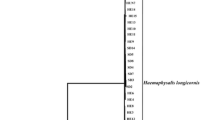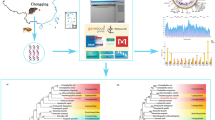Abstract
Different Tunga penetrans isolates from various hosts obtained from South America (Fortaleza. Brazil) have been studied by nucleotide sequence comparison of the first and the second internal transcribed spacer (ITS1, ITS2) of the ribosomal deoxyribonucleic acid (rDNA) and part of the mitochondrial 16S rDNA. Results show no significant host-dependent sequence differences. No indication for intraindividual and intraspecific polymorphisms could be detected. Comparing the ITS1 spacer region of T. penetrans from South America with that from Africa (Togo, Cameroon), distinct length variations have been observed caused by a repetitive sequence motif of 99 bp. The ITS1 from the South American T. penetrans contain two tandemly repeated copies, whereas four of these units are present in the spacer of the African T. penetrans. The absence of homogenization of these units indicates a recent separation of both populations. However, the different number of repetitions together with two base substitutions put the evolutionary distance of only 135 years as postulated for the transfer of T. penetrans from South America to Africa into question. Repetitive sequences could also be detected within the ITS1 rDNA region of other flea species Ctenocephalides felis, Echidnophaga gallinacea, Pulex irritans, Spilopsyllus cuniculi, and Xenopsylla cheopis. The repeat units with lengths from 10 to 99 bp are arranged in pure tandem or interspersed. The repetitive elements observed in the ITS1 of various flea species may serve as a valuable tool for phylogeographic studies.




Similar content being viewed by others
References
Abari E (2006) Verwandtschaftsbeziehungen bei hautpenetrierenden Flöhen. Diploma thesis, Heinrich-Heine-University, Düsseldorf, Germany
Altschul SF, Madden TL, Schaffer AA, Zhang J, Zhang Z, Miller W, Lipman DJ (1997) Gapped BLAST and PSI-BLAST: a new generation of protein database search programs. Nucleic Acids Res 25:3389–3402
Barnes AM, Radovsky FJ (1969) A new Tunga (Siphonaptera) from the nearctic region with description of all stages. J Med Entomol 6:19–36
Caccone A, Amato GD, Powell JR (1988) Rates and patterns of scnDNA and mtDNA divergence within the Drosophila melanogaster subgroup. Genetics 118:671–683
Coleman AW, Mai JC (1997) Ribosomal DNA ITS-1 and ITS-2 sequence comparisons as a tool for predicting genetic relatedness. J Mol Evol 45:168–177
de Leon JH, Jones WA, Morgan DJ (2004) Molecular distinction between populations of Gonatocerus morrilli, egg parasitoids of the glassy-winged sharpshooter from Texas and California: do cryptic species exist. J Insect Sci 4:39
den Bakker HC, Gravendeel B, Kyper DW (2004) An ITS phylogeny of Leccinum and an analysis of the evolution of minisatellite-like sequences within ITS1. Mycologia 95:102–118
Dover GA, Strachan T, Coen ES, Brown SD (1982) Molecular drive. Science 218:1069
Essig A, Rinder H, Gothe R, Zahler M (1999) Genetic differentiation of mites of the genus Chorioptes (Acari: Psoroptidae). Exp Appl Acarol 23:309–318
Galtier N, Gouy M, Gautier C (1996) SEAVIEW and PHYLO_WIN: two graphic tools for sequence alignment and molecular phylogeny. Comput Appl Biosci 12:543–548
Geigy R, Suter P (1960) Zur Copulation der Flöhe. Revue Suisse Zool 67:206–210
Gordon RM (1941) The jigger flea. Lancet 2:47–49
Gouliamova DE, Hennebert GL, Smith MT, van der Walt JP (1998) Diversity and affinities among species and strains of Lipomyces. Antonie Van Leeuwenhoek 74:283–291
Harris DJ, Crandall KA (2000) Intragenomic variation within ITS1 and ITS2 of freshwater crayfishes (Decapoda: Cambaridae): implications for phylogenetic and micro satellite studies. Mol Biol Evol 17:284–291
Henning G (1904) Zur Geschichte des Sandflohs (Sarcopsylla penetrans L.) in Afrika. Naturwiss Wochenschr 20:310–312
Henry Y, Wood H, Morrissey JP, Petfalski E, Kearsey S, Tollervey D (1994) The 5′ end of yeast 5.8S rRNA is generated by exonucleases from an upstream cleavage site. EMBO J 13:2452–2463
Hesse P (1899) Die Ausbreitung des Sandflohs in Afrika. Geogr Z (Hettner) 1899:522–530
Heukelbach J, de Oliveira FA, Hesse G, Feldmeier H (2001) Tungiasis: a neglected health problem of poor communities. Trop Med Int Health 6:267–272
Heukelbach J, Costa AM, Wilcke T, Mencke N, Feldmeier H (2004) The animal reservoir of Tunga penetrans in severely affected communities of North-East Brazil. Med Vet Entomol 18:329–335
Heukelbach J, Kuenzer M, Counahan M, Feldmeier H, Speare R (2006) Correct diagnosis of current head lice infestation made by affected individuals from a hyperendemic area. Int J Dermatol 45:1437–1438
Hillis DM, Dixon MT (1991) Ribosomal DNA: molecular evolution and phylogenetic inference. Q Rev Biol 66(4):411–446
Hoeppli R (1963) Early references to the occurrence of Tunga penetrans in Tropical Africa. Acta Trop 20:143–152
Hopkins GHE, Rothschild M (1953) An illustrated catalogue of the Rothschild collection of fleas (Siphonaptera) in the British Museum, vol 1. Tungidae and Pulicidae. British Museum Natural History, London
Katoh K, Kuma K, Toh H, Miyata T (2005) MAFFT version 5: improvement in accuracy of multiple sequence alignment. Nucleic Acids Res 33:511–518
Lewis RE (1972) Notes on the geographical distribution and host preferences in the order Siphonaptera. 1. Pulicidae. J Med Entomol 9:511–520
Li KC, Chin TH (1957) Tunga callida sp. new, A new species of sand flea from Yunnan. Acta Entomol Sin 7:113–120
Linardi PM, Guomaraes LR (1993) Systematic review of genera and subgenera of Rhopalopsyllinae (Siphonaptera: Rhopalopsyllidae) by phenetic and cladistic methods. J Med Entomol 30(1):161–170
Luchetti A, Mantovani B, Pampiglione S, Trentini M (2005) Molecular characterization of Tunga trimamillata and T. penetrans (Insecta, Siphonaptera, Tungidae): taxonomy and genetic variability. Parasite 12:123–129
Luchetti A, Trentini M, Pampiglone S, Fiorawanti ML Mantovani B (2007) Genetic variability of Tunga penetrans (Siphonaptera, Tungidae) sand fleas across South America and Africa. Parasitol Res 100:593–598
Morgan UM, **ao L, Fayer R, Graczyk TK, Lal AA, Deplazes P, Thompson RC (1999) Polygenetic analysis of Cryptosporidium isolates from captive reptiles using 18S rDNA sequence data and random amplified polymorphic DNA analysis. J Parasitol. 85:525–530
Paskewitz SM, Wesson DM, Collins FH (1993) The internal transcribed spacers of ribosomal DNA in five members of the Anopheles gambiae species complex. Insect Mol Biol 2:247–257
Platas G, Acero J, Borkowski JA, Gonzalez V, Portal MA, Rubio V, Sanchez-Ballesteros J, Salazar O, Pelaez F (2001) Presence of a simple tandem repeat in the ITS1 region of the Xylariales. Curr Microbiol 43:43–50
Rice P, Longden I, Bleasby A (2000) EMBOSS: the European Molecular Biology Open Software Suite. Trends Genet 16:276–277
Sanusi ID, Brown EB, Shepard TG, Grafton WD (1989) Tungiasis: report of one case and review of the 14 reported cases in the United States. J Am Acad Dermatol 20:941–944
Schlötterer C, Hauser MT, von Haeseler A, Tautz D (1994) Comparative evolutionary analysis of rDNA ITS regions in Drosophila. Mol Biol Evol 11:513–522
Smit FGAM (1962) A new sand-flea from Ecuador. Entomologist 95:89–93
Smit FG, Rosicky B (1972) Some Siphonaptera from Chile. Folia Parasitol 19:365–368
Tang J, Toe L, Back C, Unnasch TR (1996) Intra-specific heterogeneity of the rDNA internal transcribed spacer in the Simulium damnosum (Diptera: Simuliidae) complex. Mol Biol Evol 13:244–252
Thompson JD, Gibson TJ, Plewniak F, Jeanmougin F, Higgins DG (1997) The CLUSTAL_X windows interface: flexible strategies for multiple sequence alignment aided by quality analysis tools. Nucleic Acids Res 25:4876–4882
Thweatt R, Lee JC (1990) Yeast precursor ribosomal RNA. Molecular cloning and probing the higher-order structure of the internal transcribed spacer I by kethoxal and dimethylsulfate modification. J Mol Biol 211:305–320
van Herwerden L, Blair D, Agatsuma T (1998) Intra-and inter-specific variation in nuclear ribosomal internal transcribed spacer 1 of the Schistosoma japonicum species complex. Parasitology 116:311–317
Vobis M (2002) Flöhe und ihre molekularbiologische Charakterisierung. Diploma thesis, Heinrich-Heine-University Düsseldorf, Germany
Vobis M, D’Haese J, Mehlhorn H, Mencke N, Blagburn BL, Bond R, Denholm I, Dryden MW, Payne P, Rust MK, Schroeder I, Vaughn MB, Bledsoe D (2004) Molecular phylogeny of isolates of Ctenocephalides felis and related species based on analysis of ITS1, ITS2 and mitochondrial 16S rDNA sequences and random binding primers. Parasitol Res 94:219–226
Vobis M, D’Haese J, Mehlhorn H, Heukelbach J, Mencke N, Feldmeier H (2005) Molecular biological investigations of Brazilian Tunga sp. isolates from man, dogs, cats, pigs and rats. Parasitol Res 96:107–112
Vogler AP, DeSalle R (1994) Evolution and phylogenetic information content of the ITS-1 region in the tiger beetle Cicindela dorsalis. Mol Biol Evol 11:393–405
Von der Schulenburg JH, Englisch U, Wagele JW (1999) Evolution of ITS1 rDNA in the Digenea (Plathelminthes: trematoda): 3′ end sequence conservation and its phylogenetic utility. J Mol Evol 48(1):2–12
Von der Schulenburg JH, Hancock JM, Pagnamenta A, Sloggett JJ, Majerus ME, Hurst GD (2001) Extreme length and length variation in the first ribosomal internal transcribed spacer of ladybird beetles (Coleoptera: Coccinellidae). Mol Biol Evol 18:648–660
Warberg R, Jensen KT, Frydenberg J (2005) Repetitive sequences in the ITS1 region of ribosomal DNA in congeneric microphallid species (Trematoda: Digenea). Parasitol Res 97:420–423
Acknowledgment
We wish to thank Elizabeth Abari and Nadine Nagy for kindly providing Fortaleza Tunga penatrans samples as well as Prof. Dr. K Dogba (Togo) and Prof. Dr. Njayon (Cameroon) for sending fleas captured in their countries.
Author information
Authors and Affiliations
Corresponding author
Rights and permissions
About this article
Cite this article
Gamerschlag, S., Mehlhorn, H., Heukelbach, J. et al. Repetitive sequences in the ITS1 region of the ribosomal DNA of Tunga penetrans and other flea species (Insecta, Siphonaptera). Parasitol Res 102, 193–199 (2008). https://doi.org/10.1007/s00436-007-0743-0
Received:
Accepted:
Published:
Issue Date:
DOI: https://doi.org/10.1007/s00436-007-0743-0




